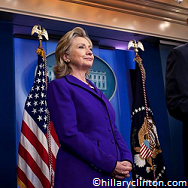 Grant Glovin, Sabin Center Summer Intern
Grant Glovin, Sabin Center Summer Intern
Hillary Clinton’s climate change plan, released last week, centers on two goals: installing 500 million solar panels by 2021, and, relatedly, adding enough electric generation capacity from renewable sources to supply all residential electricity needs. The plan appears ambitious: the solar power expansion alone would represent a sevenfold increase in the country’s current solar generating capacity.
The steps that Clinton proposes to achieve these goals have yet to be fully detailed, and the campaign has promised that Clinton will put forward “a comprehensive energy and climate agenda…over the coming months.” Her current proposals include the implementation (and defense from legal challenge) of the Obama administration’s Clean Power Plan, which mandates emissions reductions from existing power plants that will be achieved, at least in part, through the installation of new renewable energy facilities. The second component of Clinton’s plan is a “Clean Energy Challenge.” This encompasses multiple strategies, including market-based incentives and grants for states with stricter greenhouse gas (GHG) emission standards, further incentives for states localities to streamline approval processes for solar energy-generating facilities, the expansion of clean energy programs in the Department of Agriculture’s Rural Utilities Service, federal tax incentives for renewable energy projects, expanded development of renewable energy projects on federal land and buildings, and increased investment in clean energy technology research.
Some of these proposals will undoubtedly be easier to implement than others—federal tax incentives, for example will require legislative approval, potentially difficult if Congress remains in Republican control. Clinton also calls for “an initiative to significantly increase hydropower generation from existing dams across the US,” but given the effects of drought on western reservoir levels this may prove difficult. (Clinton has not yet specified what this initiative would entail.) Other aspects of the plan may be easier to carry out, including the financial incentives for states and localities to switch to renewable energy. These efforts would also be helped by the new Clean Power Plan, which requires states to submit final plans by 2018 to cut GHG emissions to targets specified by the EPA.
Still, environmentalists have criticized Clinton’s climate change proposals for not addressing certain issues they find key. Those issues include the Keystone XL pipeline, on which she has not commented, resulting in protests at some events. In contrast, other Democratic candidates, including Martin O’Malley and Bernie Sanders, have expressed strong opposition to Keystone. Some activists have also called for a stronger condemnation of fossil fuel extraction in the Arctic, while Clinton has merely expressed “doubts about whether we should continue drilling in the Arctic.” The New York Times editorial board also points out that Clinton’s plan does not call for a carbon tax or any similar fee, or even mention the possibility of a cap-and-trade system or other carbon marketplace. Finally, Clinton’s plan is frequently compared to climate action plans introduced by Sanders and O’Malley, which are more ambitious than that proposed by Clinton. O’Malley, for example, is calling for a total switch to renewable power by 2050. Climate Progress has published an infographic comparing the three plans.
As noted above, the two goals announced by Clinton last week are the first part of a “comprehensive energy and climate agenda” that will be announced in the coming months. Thus, it is difficult to assess the strength of Clinton’s climate policy at this time. The renewable energy targets are promising: her plan would lead to renewable power making up 33% of U.S. electric generation in 2027, rather than 28% in 2030 under the finalized Clean Power Plan. (When Clinton released her plan only the draft Clean Power Plan was available, which would have led to 25% of energy capacity being from renewable sources in 2027. This value is reflected in her fact sheet.) This is particularly notable because the finalized plan, though stronger than the draft version, has been critiqued for requiring a growth in renewable energy capacity slower than current trends. But there are other issues that she has yet to address. For example, Clinton’s lack of a firm position on Arctic drilling makes it difficult to assess her commitment to sharp cuts in fossil fuel use, although her hesitant comments are encouraging, as is the way she cites her past record in her fact sheet, saying she “was part of a bipartisan coalition to protect the Arctic National Wildlife Refuge from oil drilling.” There is also no discussion of climate change adaptation and only a brief mention of energy efficiency in the plan, although no candidate has been particularly vocal about adaptation and only O’Malley has proposed efficiency measures.
The political gains from Clinton presenting her climate change are apparent: Iowans in particular stand to gain from an expansion of wind energy, a January poll found that two thirds of respondents said “they were more likely to vote for political candidates who campaign on fighting climate change,” and the plan has been well received by Tom Steyer, an environmentalist and potential donor. It is possible that Clinton will continue to build political support as she unveils additional components of her energy and climate agenda, and that climate-related issues will feature more prominently in this cycle’s Democratic primary than they previously have.


